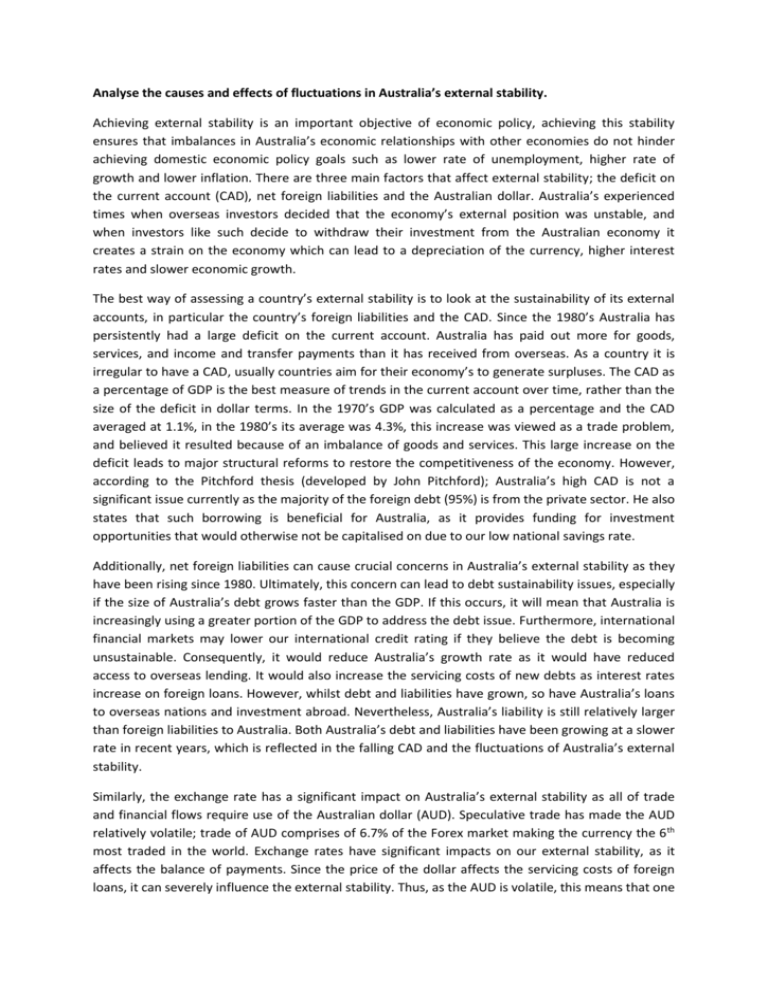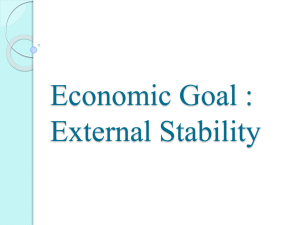Analyse the causes and effects of fluctuations in Australia's external
advertisement

Analyse the causes and effects of fluctuations in Australia’s external stability. Achieving external stability is an important objective of economic policy, achieving this stability ensures that imbalances in Australia’s economic relationships with other economies do not hinder achieving domestic economic policy goals such as lower rate of unemployment, higher rate of growth and lower inflation. There are three main factors that affect external stability; the deficit on the current account (CAD), net foreign liabilities and the Australian dollar. Australia’s experienced times when overseas investors decided that the economy’s external position was unstable, and when investors like such decide to withdraw their investment from the Australian economy it creates a strain on the economy which can lead to a depreciation of the currency, higher interest rates and slower economic growth. The best way of assessing a country’s external stability is to look at the sustainability of its external accounts, in particular the country’s foreign liabilities and the CAD. Since the 1980’s Australia has persistently had a large deficit on the current account. Australia has paid out more for goods, services, and income and transfer payments than it has received from overseas. As a country it is irregular to have a CAD, usually countries aim for their economy’s to generate surpluses. The CAD as a percentage of GDP is the best measure of trends in the current account over time, rather than the size of the deficit in dollar terms. In the 1970’s GDP was calculated as a percentage and the CAD averaged at 1.1%, in the 1980’s its average was 4.3%, this increase was viewed as a trade problem, and believed it resulted because of an imbalance of goods and services. This large increase on the deficit leads to major structural reforms to restore the competitiveness of the economy. However, according to the Pitchford thesis (developed by John Pitchford); Australia’s high CAD is not a significant issue currently as the majority of the foreign debt (95%) is from the private sector. He also states that such borrowing is beneficial for Australia, as it provides funding for investment opportunities that would otherwise not be capitalised on due to our low national savings rate. Additionally, net foreign liabilities can cause crucial concerns in Australia’s external stability as they have been rising since 1980. Ultimately, this concern can lead to debt sustainability issues, especially if the size of Australia’s debt grows faster than the GDP. If this occurs, it will mean that Australia is increasingly using a greater portion of the GDP to address the debt issue. Furthermore, international financial markets may lower our international credit rating if they believe the debt is becoming unsustainable. Consequently, it would reduce Australia’s growth rate as it would have reduced access to overseas lending. It would also increase the servicing costs of new debts as interest rates increase on foreign loans. However, whilst debt and liabilities have grown, so have Australia’s loans to overseas nations and investment abroad. Nevertheless, Australia’s liability is still relatively larger than foreign liabilities to Australia. Both Australia’s debt and liabilities have been growing at a slower rate in recent years, which is reflected in the falling CAD and the fluctuations of Australia’s external stability. Similarly, the exchange rate has a significant impact on Australia’s external stability as all of trade and financial flows require use of the Australian dollar (AUD). Speculative trade has made the AUD relatively volatile; trade of AUD comprises of 6.7% of the Forex market making the currency the 6 th most traded in the world. Exchange rates have significant impacts on our external stability, as it affects the balance of payments. Since the price of the dollar affects the servicing costs of foreign loans, it can severely influence the external stability. Thus, as the AUD is volatile, this means that one of the most important indicators of external stability, the balance of payments, will also be vulnerable. The vulnerability can adversely affect foreign investor confidence in Australia which can undermine growth. Moreover, if investor confidence is low, it can lead to a mass exodus of foreign liabilities in Australia, further reducing the exchange rate. In order to resolve concerns caused by the fluctuations of Australia’s external stability; specific policies are implemented to counteract the issues. Contractionary fiscal and monetary policy in the 1980s was aimed at reducing consumption and investment to lower CAD. Additionally, microeconomic reform policies in the 1980s were aimed at lifting Australia’s efficiency and international competitiveness. Similarly, the Howard Government adopted fiscal policy aimed at mid – term stability, which was intended to ensure that the Government would not rely on savings used to otherwise fund domestic investment; i.e. prevent the Crowding out theory. In recent years, external stability has not been a major objective of microeconomic policy – this is because most of Australia’s CAD from the private sector which doesn’t require government intervention. Many key ideas of Australia’s economic framework indirectly aid in achieving external stability. Such examples include boosting international competitiveness, constraining growth of foreign debt and maintaining investor confidence in Australia. The GFC has led to Australia giving more thought to external stability to avoid a severe debt problem in the private sector; observing the CAD and trade balance, fiscal deficit, foreign debt, interest rates and inflation. Hence, through a thorough analysis of factors which cause fluctuations in Australia’s external stability, there is a strong conclusion that the effects which follow can have both beneficial and detrimental impacts on Australia’s external stability and economy in general.








